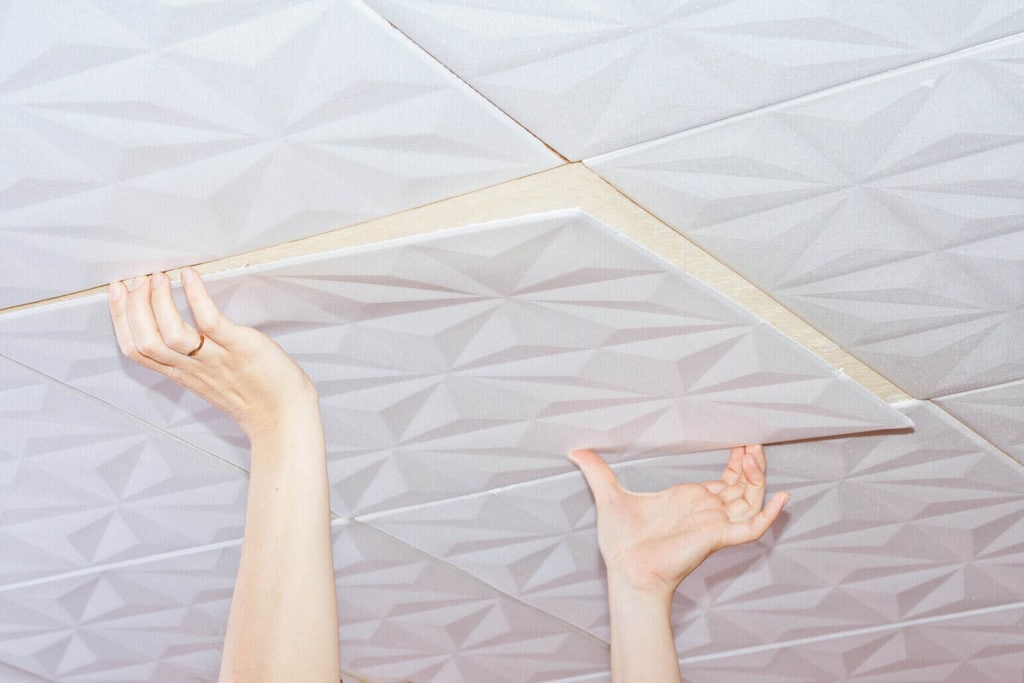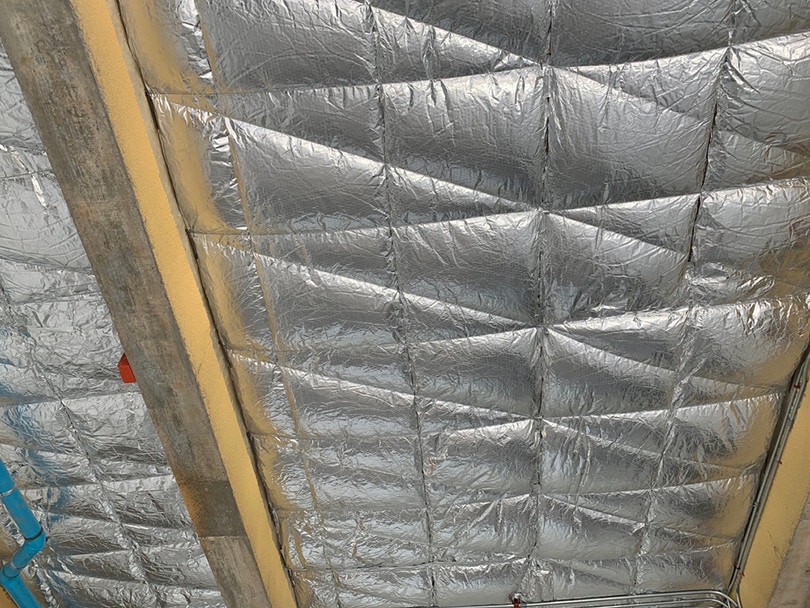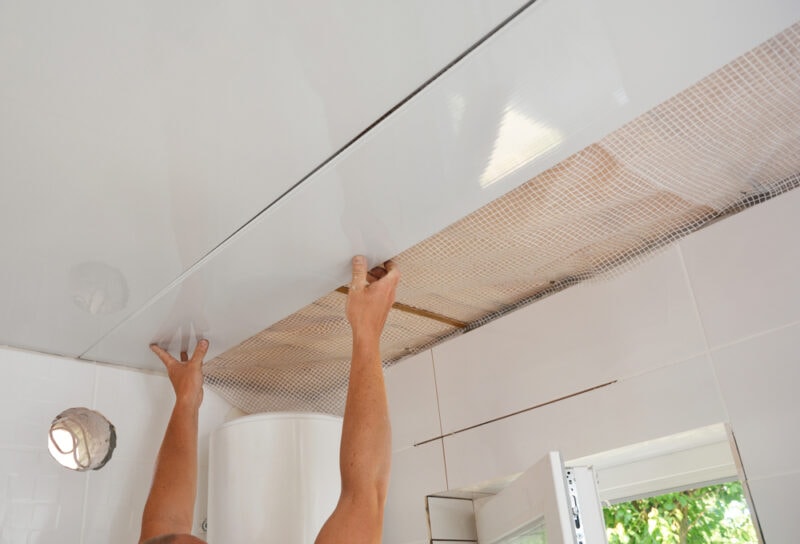How to Soundproof a Ceiling: 5 Tips & Tricks
-
Pete Ortiz
- Last updated:

Have you ever asked yourself why people soundproof their ceilings? If you thought it’s because they are trying to isolate themselves from the world, that’s not the case. What they are essentially doing, is trying to reduce the noises that are slowly making their apartments uninhabitable, i.e., airborne and impact noises.
The best example of an impact noise is the noise made by the tenants living upstairs, anytime they drag tables or chairs around. Another example is the footfall that keeps you up at night, whenever you’re trying to catch some Zs.
It’s important to note that noises are principally vibrations made by different objects. And that means that one of its chief properties is its ability to travel through solid structures. Mind you, sound often travels relatively faster in solids, in comparison to liquids or gasses.
That’s due to the fact that solid molecules are bonded close together, making it easier for the vibrations to be transmitted.
Airborne noises are the sounds that find their way through open spaces. Even though the ceiling looks like a tightly fitted home feature, there are still a lot of tiny spaces in between the cracks. And it’s through those spaces that you’ll hear the voices of people conversing on the top floor, or the music that they are listening to.
Needless to say, if you’re looking for a more peaceful, private, and quieter environment, here are five tips and tricks to use.
5 Surefire Tips on How to Soundproof the Ceiling
1. Figure Out Your Ceiling Type

It’s no secret that there is more than one type of ceiling. The traditional type is the one that has drywall nailed to the wooden joists. The beam ceilings are also considered conventional, but we can’t say the same thing about coffered ceilings, V-shaped cathedrals, trays, sloped sheds, or coved.
It’s important to first figure out the type of ceiling that has been installed to determine the best method of approaching the problem. Some of these ceilings have to be soundproofed from a different floor to preserve their aesthetic appeal.
2. Identify the Type of Noise
What type of noise is making you lose your mind? Is it the music that they keep playing? Or the screeching sound of household items being dragged around?
The answers to these questions will help you choose a suitable soundproofing technique. If it’s the music, then we have to apply a noise-proofing sealant on cracks found in the sealing. But if it’s impact noise, then decoupling the ceiling surfaces might be the way to go.
3. Add Mass
While studying the physics of sound transmission, you’ll come across the various principles of soundproofing. And one of those principles intricately explains how solids absorb sound better than other forms of matter.
Basically, what it says is, any solid matter that’s comparatively heavier and thicker will have the capacity to block more sound vibrations.
Thanks to this principle, tenants and property owners who easily get irritated by airborne noises know exactly what they have to do to eliminate such noises. If the walls are the problem, you could use a piece of furniture to add mass and block out those soft noises.
But that’s not an option in the case of a ceiling because heavy pieces of furniture aren’t light enough to be attached to ceilings — even if it was doable, walking into a room and finding different pieces of furniture nailed to the ceiling is just weird.
That leaves us with the mass-loaded vinyl option. This material is very easy to work with, and heavy enough to block out all noises.
4. Decoupling the Ceiling Surfaces
Attaching mass-loaded vinyl to your ceilings will only deal with airborne noises. If you wish to eliminate the impact noises, you’ll have to separate the ceiling’s drywall from its wooden joists, and then connect them using resilient channels.
By separating those two surfaces, you’ll now have some space left in between them. And like we said earlier, sound vibrations don’t like traveling through gases or air. It will be difficult for the vibrations to seamlessly move from the joists to the drywall, thus reducing the noise.
By the way, resilient channels are specifically designed to dampen sound waves in ceilings.
5. Add Some Sound-Absorbing Materials
For the record, a sound-absorbing material is not the same as a soundproofing one. The former can’t stop noises from entering or leaving a room, while the latter can. We often use sound-absorbing materials to refine the acoustics inside a room.
For instance, when we’re looking to manage the reverberations of sound or echoing, you’ll need to cover the walls with sound-absorbing material.
We’ve already soundproofed the ceiling, and now we need to make it impenetrable to any noise. So, what we’ll do is to either use a porous absorber, a membrane absorber, or a resonance absorber.
Each one of them comes with a short list of pros and cons, so make sure that you’re well-acquainted before starting the installation process.
What If the Noises Are Still Getting Through?
If you can still hear noises from the other side, then maybe the problem is not with the ceiling, but with the vents. Ventilation is one of the most crucial features in any room. While most residential houses have ventilation outlets located on the walls, some have them installed in the ceilings.
So that’s like having an open hole in the ceiling, that’s connected to literally every room on that floor. You could stuff it with some acoustic foam, cover it using soundproof blankets, fill it with an acoustic sealant, or just block it entirely using drywall. Whatever trick tickles your fancy.
Will Insulating the Ceiling Joists Reduce the Noise?
Yes, it’s always considered an effective soundproofing technique. But insulating the joists is a preferred method for the guys working from the inside out. That is to say, you’ll be working from your apartment, and not from the neighbor’s.
Also, since there’s more than one type of insulation, you shouldn’t go for whatever’s accessible. Go for a material that’s easy to install because DIY projects ought to be easy. Our number one pick for this type of project is the fiberglass batt insulation.
The primary task of insulation is to prevent air from passing through the ceilings or walls. So once installed, no air will be able to carry airborne noises from one room to the next, not even through those ventilation outlets.

Is It Possible to Soundproof Ceilings Against Footfalls?
Managing footfalls is much easier than any other noise. Just politely ask your neighbor to install carpets or a memory foam underlay. And if they’ve already installed a carpet, but the sounds are still very audible, ask them to stack an additional layer on top of the existing one. That will create a solid mass barrier that will absorb most of the sounds even before they get to the next floor.
Stabilizing the floorboards is an option, just so you know. Especially in rooms that have a lot of foot traffic.
Over time, those boards tend to become loose, thus causing too much noise for the residents living on the bottom floor. If you don’t have time to fix them, reposition the pieces of furniture in a way that forces guys to walk on firmer ground.
Is Soundproofing the Ceiling Expensive?
Of course, we cannot give you an exact number because the total costs of these kinds of projects are normally influenced by a lot of factors. We’ll have to factor in the state you’re in, the amount of space that you’ll be covering, the quality of materials, labor costs (in case you’ll need a crew), etc.
All we can say for sure is, if you’re planning to be thorough with the process, it’s definitely going to break your bank. And don’t even think about outsourcing if you’d wish to mitigate the effects of the costs, seeing as that would only worsen the situation. Professionals have to charge top dollar to cater to their business needs and be left with enough to put food on their table.
Is Soundproofing the Ceiling Necessary?
We don’t know if you’ve heard this, but noises can significantly affect your mental health in the long run. We even have studies that have tested and reported that people who were exposed to noises at a manageable level presented signs of depression and increased anxiety. Treating such conditions also costs money. So… Yes, we honestly believe soundproofing your ceilings is necessary, as a preventative measure.

Is Damping an Effective Soundproofing Technique?
It actually is. The process of damping will require you to use damping compounds, which are substances designed to transform sound into heat energy. Consequently, this stops the vibrations from spreading to other rooms on the same floor.
So far, we think Green Glue is the most popular and effective sound-damping compound on the market. Its polymeric formula is very unique and efficient at converting the noise’s mechanical energy into heat energy. Also, it’s versatile and easy to apply in DIY projects.
Final Thoughts
While working on these types of projects, you need to try to manage your expectations. We like to tell our audiences that moderating the noise should be your number one priority, not blocking it entirely.
If you go in expecting to mute everything, you’ll come out disappointed or feeling wasted. And that, my friends, is also not good for your mental health.
Featured Image Credit: mozz.art, Shutterstock
Contents



